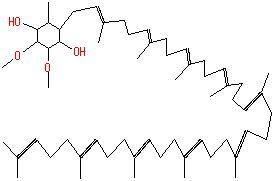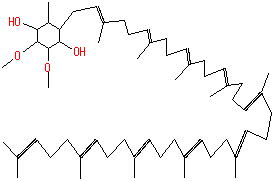Record Information Version
1.0 Update Date
1/22/2018 11:54:54 AM
Metabolite ID PAMDB110697
Identification Name:
ubiquinol(50) Description: Not Available
Structure
Synonyms:
ubiquinol
ubiquinol-10
reduced ubiquinone
dihydroubiquinone
Chemical Formula:
C59 H92 O4
Average Molecular Weight:
865.37 Monoisotopic Molecular
Weight:
864.6995614416 InChI Key:
Not Available InChI: Not Available CAS
number:
Not Available IUPAC Name: Not Available
Traditional IUPAC Name:
Not Available SMILES: CC(CCC=C(CCC=C(CCC=C(CCC=C(C)CCC=C(CCC=C(C)CCC=C(CCC=C(CCC=C(C)C)C)C)C)C)C)C)=CCc1(c(O)c(OC)c(OC)c(c(C)1)O)
Chemical Taxonomy
Taxonomy Description This compound belongs to the class of organic compounds known as polyprenyl quinols. These are compounds containing a polyisoprene chain attached to a quinol(hydroquinone) at the second ring position.
Kingdom
Organic compounds Super Class Lipids and lipid-like molecules
Class
Prenol lipids Sub Class Quinone and hydroquinone lipids
Direct Parent
Polyprenyl quinols Alternative Parents
Substituents
Polyterpenoid 2-polyprenyl-6-methoxyphenol Polyprenylbenzoquinol Polyprenylphenol Ubiquinol skeleton Methoxyphenol O-dimethoxybenzene Dimethoxybenzene Anisole Hydroquinone M-cresol Phenoxy compound O-cresol Phenol ether Methoxybenzene Alkyl aryl ether Phenol Toluene Monocyclic benzene moiety Benzenoid Ether Organooxygen compound Organic oxygen compound Hydrocarbon derivative Aromatic homomonocyclic compound Molecular Framework
Aromatic homomonocyclic compounds External Descriptors
Physical Properties State:
Not Available Charge: Not Available
Melting point:
Not Available Experimental Properties:
Not Available Predicted Properties
Biological Properties Cellular Locations:
Not Available Reactions:
Pathways:
Spectra Spectra:
Not Available
References References:
Not Available Synthesis Reference:
Not Available Material Safety Data Sheet (MSDS)
Not Available
Links External Links:
This project is supported by
the University of Maryland ,
School of Pharmacy ,
Mass Spectrometry Center , a Waters Center of Excellence. The center is an NIH-investigator funded research and core facility that supports a wide range of cutting-edge metabolomic studies. The Center is supported through a center grant from the University of Maryland and NIH grants to its members. The PAMDB project is affiliated with
The Metabolomics Innovation Centre (TMIC) a leading metabolomics research and service center funded through Genome Alberta, Genome British Columbia and Genome Canada.


